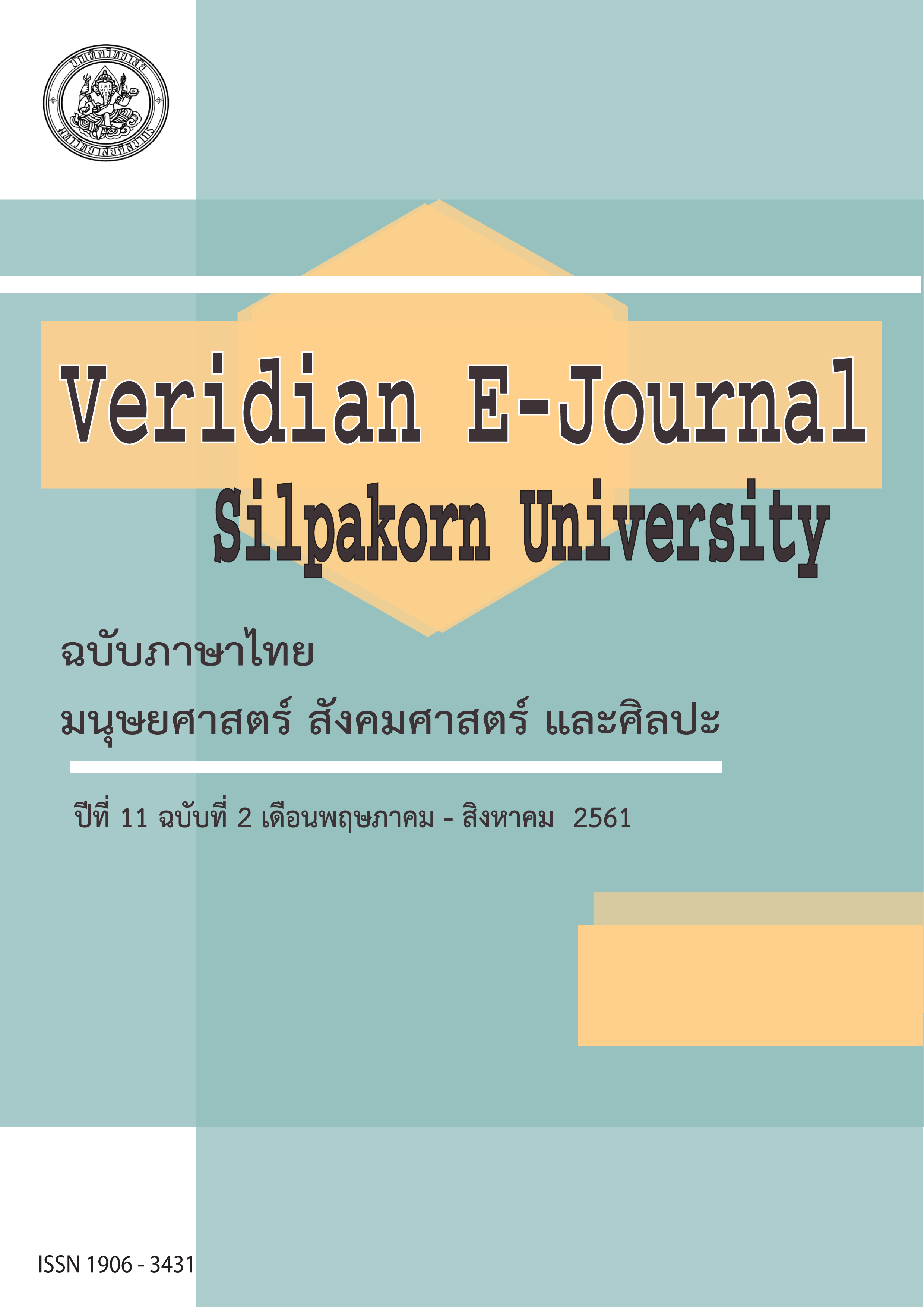การพัฒนากิจกรรมพัฒนาผู้เรียนตามแนวการเรียนรู้โดยใช้กิจกรรมเป็นฐาน ร่วมกับแนวคิดห้องเรียนกลับด้านเพื่อส่งเสริมคุณลักษณะพลเมืองอาเซียน สำหรับนักเรียนชั้นมัธยมศึกษาตอนต้น (The Development of Learner Developing Activities through Activities-Based Learning -) The Development of Learner Developing Activities through Activities-Based Learning with Flipped Classroom to Enhance The Desirable Characteristics of ASEAN Citizens in Secondary Students.
Main Article Content
Abstract
การวิจัยในครั้งนี้มีวัตถุประสงค์เพื่อพัฒนาและศึกษาคุณภาพของกิจกรรมพัฒนาผู้เรียนตามแนวการเรียนรู้โดยใช้กิจกรรมเป็นฐานร่วมกับแนวคิดห้องเรียนกลับด้านเพื่อส่งเสริมคุณลักษณะพลเมืองอาเซียน สำหรับนักเรียนชั้นมัธยมศึกษา ดำเนินวิจัยตามขั้นตอนของการวิจัยและพัฒนา (Research and Development : R&D) ซึ่งแบ่งเป็น 4 ขั้นตอน ดังนี้ 1)ศึกษาข้อมูลพื้นฐานและความต้องการ เครื่องมือที่ใช้ในการวิจัยประกอบด้วย แบบสอบถามความต้องการเกี่ยวกับการพัฒนากิจกรรมพัฒนาผู้เรียน และแบบสัมภาษณ์ผู้ทรงคุณวุฒิ 2) พัฒนากิจกรรมพัฒนาผู้เรียน 3) ตรวจสอบคุณภาพหาความเที่ยงตรงโดยผู้เชี่ยวชาญ เครื่องมือที่ใช้ในการวิจัยคือ แบบประเมินแผนจัดกิจกรรมพัฒนาผู้เรียน 4) ศึกษาคุณภาพโดยทดลองใช้แผนจัดกิจกรรมพัฒนาผู้เรียน ไปทดลองใช้กับนักเรียนชั้นมัธยมศึกษาตอนต้น โรงเรียนสาธิตมหาวิทยาลัยศิลปากร ที่ไม่ใช่กลุ่มตัวอย่าง จากการคัดเลือกแบบอาสาสมัคร (Voluntary Selection) มาหาคุณภาพตามวงจร PDCA วิเคราะห์ข้อมูลโดยการหาค่าเฉลี่ย ( ) ค่าเบี่ยงเบนมาตรฐาน (S.D.) และการวิเคราะห์เนื้อหา (Content Analysis)
The purpose of this study was to develop and test the quality of learner developing activities through activities-based learning with flipped classroom to enhance the desirable characteristics of ASEAN citizens in secondary students. The study was conducted as the procedure of research and development: R&D which was divided into 4 steps as follows. 1) to collate the general information and needs. The instruments used in this study were questionnaires of learner developing activities and the format for expert interviews. 2.) to develop learner developing activities 3) to test the quality of instrument validity by experts and the instruments used was the evaluation form of lesson plans for learner developing activities 4) test the quality by trying out the lesson plans for learner developing activities with secondary students of the Demonstration School of Silpakorn University who were not the sample of this study by voluntary selection and test the quality through PDCA procedure. The collected data was analyzed for Mean ( ), Standard Deviation (S.D.) and Content Analysis.
The study revealed that the elements of learner developing activities through activities-based learning with flipped classroom to enhance the desirable characteristics of ASEAN citizens in secondary students consisted of 7 elements: 1) topic 2) key concept 3) objective 4) content activity 5) activity procedures which consisted of 6 steps: (1) preparation (2) outside classroom learning (3) warm up (4) doing activities (5) discussion (6) evaluation 6) measurement and evaluation methods and 7) materials and equipment and the quality of learner developing activities through activities-based learning with flipped classroom. It was found that the mean ( ) of all aspects was 4.70 and standard deviation was less than 0.03. So, it revealed that the quality in the aspect of content validity was the most agreeable. The testing of PDCA procedure quality was founded that 1) preparation step to reduce time for content preparation. Actually, the teachers didn’t have to make the materials themselves in some topics, but they could use ones they already had. 2) Outside classroom learning: the teachers should show their opinions towards students’ answers to stimulate ones who didn’t answer the questions. 3) Warm up: the teachers should create a pleasant relaxed atmosphere in the classroom. 4) Doing activities: the teachers should explain and reiterate to all members to help each other doing tasks for group work. 5) Discussion: The teachers should give students an opportunity for those who hadn’t answered the questions to join the discussion, and 6) Evaluation: the teachers should manage the time appropriately for learning evaluation.
ผลการวิจัยพบว่า องค์ประกอบของกิจกรรมพัฒนาผู้เรียนตามแนวการเรียนรู้โดยใช้กิจกรรมเป็นฐานร่วมกับแนวคิดห้องเรียนกลับด้านเพื่อส่งเสริมคุณลักษณะพลเมืองอาเซียนสำหรับนักเรียนชั้นมัธยมศึกษาตอนต้น ประกอบด้วย 7 องค์ประกอบ คือ 1) ชื่อเรื่อง 2) สาระสำคัญ 3) จุดประสงค์ 4) เนื้อหากิจกรรม 5) วิธีดำเนินกิจกรรม มี 6 ขั้นตอน คือ (1) ขั้นเตรียมการ (2) ขั้นเรียนรู้นอกห้องเรียน (3) ขั้นนำ (4) ขั้นปฏิบัติกิจกรรม (5) ขั้นอภิปราย และ (6) ขั้นประเมินผล 6) วิธีวัดและประเมินผล และ 7) สื่อและอุปกรณ์ และคุณภาพของกิจกรรมพัฒนาผู้เรียนตามแนวการเรียนรู้โดยใช้กิจกรรมเป็นฐานร่วมกับแนวคิดห้องเรียนกลับด้านพบว่า ทุกรายการประเมินมีค่าเฉลี่ย ( ) 4.70 และค่าเบี่ยงเบนมาตรฐาน (S.D.) 0.03 ซึ่งแสดงว่า มีคุณภาพด้านความเที่ยงตรงเชิงเนื้อหา (Content Validity) สอดคล้องมากที่สุด และการศึกษาคุณภาพตามวงจร PDCA พบว่า 1) ขั้นเตรียมการ เพื่อลดระยะเวลาการเตรียมการในเนื้อหาบางเรื่องครูอาจไม่ถึงขั้นทำสื่อเอง แต่อาจหาสื่อที่เกี่ยวข้องที่มีอยู่แล้วมาใช้ 2) ขั้นเรียนรู้นอกห้องเรียน ครูควรเข้าไปแสดงความคิดเห็นต่อการตอบคำถามของนักเรียนเพื่อกระตุ้นให้นักเรียนที่ยังไม่ตอบคำถามมาตอบให้ครบทุกคน 3) ขั้นนำ ครูควรสร้างบรรยากาศในชั้นเรียนให้มีความเป็นกันเองก่อนเริ่มกิจกรรมขั้นนำ 4) ขั้นปฏิบัติกิจกรรม กิจกรรมกลุ่มครูควรชี้แจงให้นักเรียนแต่ละกลุ่มได้ให้สมาชิกในกลุ่มทุกคนมีบทบาท ไม่ผูกขาดการทำงานเพียงคนใดคนหนึ่ง 5) ขั้นอภิปรายแลกเปลี่ยนเรียนรู้ ครูควรเปิดโอกาสให้นักเรียนที่ยังไม่ตอบตอบคำถามหรือมีส่วนร่วมในการอภิปรายได้มีส่วนร่วม และ 6) ขั้นประเมินผล ครูควรบริหารเวลาในคาบเพื่อให้เพียงพอต่อการประเมินผลการเรียนรู้ของนักเรียน

